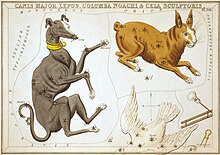Lepus (constellation)
| Constellation | |
 | |
| Abbreviation | Lep |
|---|---|
| Genitive | Leporis |
| Pronunciation | /ˈliːpəs/, or colloquially /ˈlɛpəs/; genitive /ˈlɛpər[invalid input: 'ɨ']s/ |
| Symbolism | the Hare |
| Right ascension | 6 |
| Declination | −20 |
| Quadrant | NQ2 |
| Area | 290 sq. deg. (51st) |
| Main stars | 8 |
| Bayer/Flamsteed stars | 20 |
| Stars with planets | 3 |
| Stars brighter than 3.00m | 2 |
| Stars within 10.00 pc (32.62 ly) | 3 |
| Brightest star | α Lep (Arneb) (2.58m) |
| Messier objects | 1 |
| Meteor showers | None |
| Bordering constellations | Orion Monoceros Canis Major Columba Caelum Eridanus |
| Visible at latitudes between +63° and −90°. Best visible at 21:00 (9 p.m.) during the month of January. | |
Lepus (/ˈliːpəs/, colloquially /ˈlɛpəs/) is a constellation lying just south of the celestial equator, immediately south of Orion. Its name is Latin for hare. Although the hare does not represent any particular figure in Greek mythology, Lepus was one of the 48 constellations listed by the 2nd century astronomer Ptolemy, and it remains one of the 88 modern constellations. It is located below the constellation Orion (the hunter), and is sometimes represented as a hare being chased by Orion or, alternatively, by Orion's hunting dogs.[1]
This constellation should not be confused with Lupus, the wolf.
History and mythology

Lepus is most often represented as a rabbit being hunted by Orion, whose hunting dogs (Canis Major and Canis Minor) pursue it. The constellation is also associated with some lunar mythology, including the Moon rabbit.[2]
Four stars of this constellation (α, β, γ, δ Lep) form a quadrilateral and are known as ‘Arsh al-Jawzā', "the Throne of Jawzā'" or Kursiyy al-Jawzā' al-Mu'akhkhar, "the Hindmost Chair of Jawzā'" and al-Nihāl, "the Camels Quenching Their Thirst" in Arabic.
Notable features

Stars
There are a fair number of bright stars, both single and double, in Lepus. Alpha Leporis, the brightest star of Lepus, is a white supergiant of magnitude 2.6, 1300 light-years from Earth. Its traditional name, Arneb, means "hare". Beta Leporis, called Nihal, is a yellow giant of magnitude 2.8, 159 light-years from Earth. Gamma Leporis is a double star divisible in binoculars. The primary is a yellow star of magnitude 3.6, 29 light-years from Earth. The secondary is an orange star of magnitude 6.2. Delta Leporis is a yellow giant of magnitude 3.8, 112 light-years from Earth. Epsilon Leporis is an orange giant of magnitude 3.2,[3] 227 light-years from Earth. Kappa Leporis is a double star divisible in medium aperture amateur telescopes, 560 light-years from Earth. The primary is a blue-white star of magnitude 4.4 and the secondary is a star of magnitude 7.4.[2]
There are several variable stars in Lepus. R Leporis is a Mira variable star also called "Hind's Crimson Star" for its striking red color. It varies in magnitude from a minimum of 9.8 to a maximum of 7.3, with a period of 420 days. R Leporis is at a distance of 1500 light-years. The color intensifies as the star brightens.[4] It can be as dim as magnitude 12 and as bright as magnitude 5.5. It was named for John Russell Hind.[2] T Leporis is also a Mira variable observed in detail by ESO's Very Large Telescope Interferometer.[5] RX Leporis is a semi-regular red giant that has a period of 2 months. It has a minimum magnitude of 7.4 and a maximum magnitude of 5.0.[2]
Deep-sky objects
There is one Messier Object in Lepus, M79. It is a globular cluster of magnitude 8.0, 42,000 light-years from Earth. One of the few globular clusters visible in the Northern Hemisphere winter, it is a Shapley class V cluster, which means that it has an intermediate concentration towards its center. It is often described as having a "starfish" shape. M79 was discovered in 1780 by Pierre Méchain.[6]
Notes
- ^ "Skys & Telescope: March 2008", Southern Hemisphere Highlights: by Shermend
- ^ a b c d Ridpath & Tirion 2001, pp. 170–171.
- ^ Gutierrez-Moreno, Adelina; et al. (1966). "A System of photometric standards". 1. Publicaciones Universidad de Chile, Department de Astronomy: 1–17. Bibcode:1966PDAUC...1....1G.
{{cite journal}}: Cite journal requires|journal=(help) - ^ Levy, David H. (2005), Deep Sky Objects, Prometheus Books, ISBN 1-59102-361-0
- ^ Unique Details Of Double Star In Orion Nebula And Star T Leporis Captured By 'Virtual' Telescope. ScienceDaily. Retrieved February 19, 2009, /releases/2009/02/090218103517.htm
- ^ Levy 2005, pp. 160–161. sfn error: multiple targets (2×): CITEREFLevy2005 (help)
References
- Allen, R. H. (1899). Star-names and Their Meanings. New York: G. E. Stechart.
- Kunitzsch, P.; Smart T. (2006). A Dictionary of Modern Star Names: A Short Guide to 254 Star Names and Their Derivations. Cambridge (USA): Sky Publishing Corp.
- Levy, David H. (2005). Deep Sky Objects. Prometheus Books. ISBN 1-59102-361-0.
{{cite book}}: Invalid|ref=harv(help) - Ridpath, Ian; Tirion, Wil (2001), Stars and Planets Guide, Princeton University Press, ISBN 0-691-08913-2
- Ian Ridpath and Wil Tirion (2007). Stars and Planets Guide, Collins, London. ISBN 978-0-00-725120-9. Princeton University Press, Princeton. ISBN 978-0-691-13556-4.
External links

Credit: ESO/J.-B. Le Bouquin et al.
